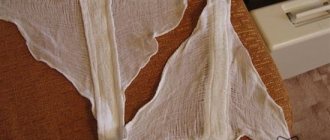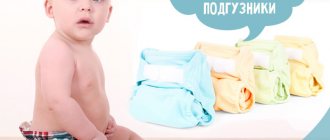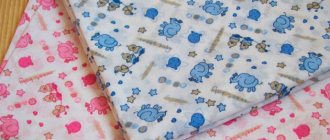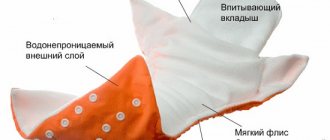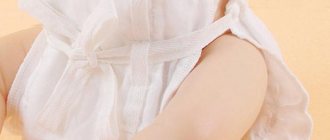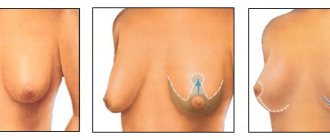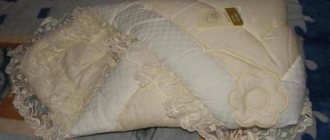Waiting for a little man is always exciting. And the closer the cherished date, the more worries you have about whether everything is ready for the baby’s arrival. Even experienced mothers sometimes get lost here, not to mention those who are expecting their first child. I want to buy everything that my eyes see in the store, and also that big bear from the top shelf. But wait, you’ll still have time to pamper your child, but while he’s very young, it’s better to be smart about spending. Moreover, there are many of them to come.
A significant expense item for a family is diapers. Let's figure out how many of them you will need for the first time and what you can save on.
How many diapers should you take to the maternity hospital?
Today, almost all maternity hospitals provide diapers, 15-20 pieces daily per baby.
If your maternity hospital does not provide this, then taking diapers with you is a necessity. When calculating your needs, consider the following:
- Number of days of stay in the maternity hospital. If the birth went well, without complications, then you and the baby will be discharged in 3-5 days. After a caesarean section, you will be allowed to go home after 5-7 days.
- Amount of urine. In the first days of their life, children pee in small quantities and not often - up to 10 times. Based on this, you will need to change a diaper filled with urine 4-5 times a day.
- Meconium formation. On the 2-3rd day, the newborn’s stomach functions return to normal, and meconium, the original feces, begins to be released. The consumption of blotter cloths will increase to 10 pieces.
For 3 days in the maternity hospital you will need 20 pieces, for 5 days - 40 pieces. The figure is given taking into account the reserve.
You can save a lot of money on diapers by using diapers provided at the maternity hospital. During the day you can swaddle your baby in them, and at night put on waterproof pads for a restful sleep.
Do I need to wake up my baby to change his diaper at night?
Experienced parents use separate diapers for nighttime sleep. It is not necessary to take specialized products. It is enough that they satisfy a number of factors:
- quickly and completely absorbed the liquid;
- did not let moisture back in;
- provided a comfortable touch to delicate skin.
Most premium branded products have these properties. They are highly absorbent and do not require changing during the night. This guarantees healthy, sound sleep for you and your baby.
If it is not possible to overpay for comfort, you need to listen more carefully to the newborn. As soon as the absorbent layer stops doing its job, the baby becomes restless. It is better to change hygiene products before he starts crying due to discomfort.
Infant hygiene has its own characteristics. They wake up several times during the night to feed. Every time you need to check the condition of the diaper. Change it in the following cases:
- Defecation. Feces have a slightly acidic environment. With prolonged contact with the skin, they irritate it. The number of allocations does not matter.
- Wet inner surface. You can encounter this when using low-quality products or when urinating excessively.
- Great filling. A diaper is considered full not only when it stops absorbing liquid. Some products have a special stripe that changes color. In other cases, the situation is assessed visually or by touch. If you feel that there is already too much liquid inside, it is time to change the absorbent panties without waiting for a leak.
Babies may poop several times during the night. Therefore, there is no need to lose vigilance after the first night diaper change.
Daily consumption of diapers in the first month
While your baby is very small, the need for them will be noticeable. As the child grows older, the number will decrease.
In addition to the baby’s age, consumption is additionally influenced by several factors:
- Air temperature in the apartment. If your home is cool enough, your baby will walk more often.
- Artificial feeding. “Artificial babies” relieve their needs less frequently than children receiving breast milk.
- Number of feedings. Babies, as a rule, immediately walk in a big way after feeding.
- Diaper absorbency. At night, it is better to use diapers with moisture absorption up to 240 ml. This is enough for 8-12 hours of sound sleep for your baby.
On average, in the first month of life, the daily consumption of blotter cloths will be 10 pieces.
Diaper consumption and methods for reducing it
It's no secret that the cost of diapers eats up a huge part of the benefit. The rule “change a diaper once every 4 hours” does not always work, as life makes adjustments.
For example, bottle-fed babies poop about 4 times a day. This means that artificial babies will need 4 prompt changes per day, plus 1 morning and 1 night diaper change. Only 6 pieces.
When breastfeeding, your baby will walk a little bigger every time he is put to the breast. If the baby is fed not by the clock (every 3 hours), but on demand, then the number of shifts can reach 10-12 per day. Let's add a morning shift and an overnight shift: we get 12-14 diapers per day. It's a lot, but what can you do?
Over time, consumption will decrease. The baby develops, his ventricle and intestines get used to working more evenly.
By three months, the number of diapers is reduced by a quarter, and by 6 months - by half.
Changing a diaper must be done in the following cases:
- After the baby poops, the bottom needs to be washed and the dirty diaper replaced with a fresh one. Avoid leaving your skin in contact with feces for long periods of time. Decaying food debris and urea cause irritation and redness of the delicate skin.
- Try to put on a new diaper before going for a walk or going to the doctor. The temperature outside is lower than at home, and a damp cloth will be unpleasantly cold for the baby.
- If your baby pees a lot but hasn't pooped yet, don't wait until he does. Change your heavy diaper to a new one.
Ways to reduce consumption
So that the family budget does not suffer unnecessarily, you can try to save on expenses
. There are three ways to do this:
- Allow the baby to “holop” at home in a diaper.
- Use special reusable diapers for newborns.
- Use gauze pads.
One more thing: if your baby poops unusually often, it's worth getting a stool test. This is possible when staphylococci multiply. After treatment, stool frequency will return to normal and diaper consumption will decrease.
Gauze insert
When the baby is 2 months old, gauze inserts can be placed in the sliders. If your baby poops, the gauze will absorb the contents. They need to be changed every time after the baby has passed a little or a big one.
Pros:
- gauze is cheap;
- it is environmentally friendly, hypoallergenic;
- Suitable for reusable use.
Minuses:
- the liner leaks and you have to wash the sliders;
- can only be used at home;
- the tissue gets bunched up and feces flows down the legs.
Walking naked
Often, when using a diaper, the baby develops diaper rash. To get rid of them, as well as to reduce the consumption of disposable diapers, the crumbs are placed on a diaper. They can be fabric (flannel) or disposable (absorbent).
Absorbent ones can be used to sleep the baby, and during the day you can place him on a flannel in the sun. This can be done when the room has warmed up above 210C.
Boys, due to their physiology, can spray not only the diaper, but also the environment, so place it on the tummy. Put a vest on top to make your baby comfortable.
Reusable diaper
Using gauze diapers will help significantly reduce family budget expenses.
There are rules for their application.
- Gauze panties must be sterile. This means that after washing they need to be boiled.
- When the gauze is dry, be sure to iron the panties with a hot iron.
- When the baby begins to sit on his butt, make sure that the gauze does not irritate the skin.
Attentive mothers advise holding the baby over a bathtub or basin after feeding so that he can pee. Take this advice to heart. Try to use waterproof panties only when going outside, and use diapers at home.
Diaper consumption depending on age
Up to 6 months, children pee frequently and profusely. After six months, the frequency decreases, but the volume of fluid released increases.
For clarity, we have collected the data in a table. It reflects the approximate number of urinations depending on the age of the child and the daily need for diapers.
| Child's age | Number of urinations per day | Volume of liquid per day, ml | Diaper moisture absorption, ml | Daily need for diapers, pcs. |
| Up to 1 month | 8-10 | 120 | 120 | 6 |
| from 1 to 6 months | 20-22 | 300-650 | 120 | 8-10 |
| From 6 months to 1-2 years | 15-18 | 400-750 | 160 | 5-7 |
| From 2 to 3 years | 6-8 | 800-900 | 240 | 0-3 |
To the calculated daily need for blotter cloths, you need to add 2-3 more pieces in case of defecation.
When choosing a diaper, pay attention to its ability to absorb moisture. This will help reduce consumption. For example, for children under 1 year old a diaper with an absorbency of 160 ml will be enough, for 3 years old - 240 ml.
And don't forget that all children develop differently. The figures in the table are averages and serve as a guideline when calculating the need for waterproof clothes for your child.
Rules for changing diapers for new parents
The diapers are easy to use, and the child feels comfortable in them. They are easy to put on and take off, but inexperienced parents still need to know how to use these products correctly to avoid additional problems.
Helpful Tips:
- You probably shouldn’t immediately buy diapers of unfamiliar quality for future use. They may not be suitable for your baby or will cause skin irritation. In this case, it is necessary to change the brand of the product.
- A clean diaper should be put on the baby only after he has been washed or bathed, and first after waiting for his skin to dry.
- To care for a newborn, you will need talc or hypoallergenic cream. Such products are needed to keep the skin clean and healthy.
- When the navel does not heal for a long time, it makes sense for the baby to buy diapers with a special cutout so as not to constantly injure the wound.
When choosing bedding for newborns, you should purchase the smallest size, but diapers are sold taking into account the baby’s weight. Therefore, if the baby is premature, he will need a model marked “0”, but if the body weight is standard, then “1”. Either a product that is too small or too large can cause discomfort and discomfort to the baby.
We recommend: How long does discharge last after childbirth?
How often should you change a diaper and how to do it
Not only your child’s mood and calmness, but also the health of his skin depends on a dry diaper. Therefore, you should not wait until it begins to “burst at the seams” from the amount of liquid inside.
Pediatricians recommend changing diapers in the following cases:
- If the child went big. Even if the diaper is slightly dirty, it should be changed immediately.
- If you fail to change it for a long time, for example, while walking or sleeping. Later you need to check if everything is okay with the diaper.
- Before visiting a doctor or massage therapist.
- After taking a bath.
- As it fills, approximately every 3-4 hours or earlier if you find wet skin underneath.
Wet skin can also be a sign that your baby is feeling hot. In this case, you need to remove the diaper and let the baby take air baths, the main thing is that the temperature in the room is not lower than 20 °C.
If the child has passed a lot, then you need to use the unstained edges of the diaper to wipe off any remaining dirt from the skin, wiping it from the front and towards the bottom. After this, the child needs to be washed with a little soapy warm water. If you have a girl, you should also wash her front and back to avoid bacteria getting into the genitals. If it is not possible to wash the child, then you can use wet wipes. Before putting on a clean diaper, you need to lubricate the skin with baby diaper rash cream.
Disposable diapers and myths about them
Persistent unfounded speculation has formed around disposable diapers
Modern mothers simply cannot imagine life without baby diapers. But once upon a time, humanity managed quite well without this hygienic accessory, using only diapers. But how? After all, diapers save time and make life much easier for parents. However, certain misconceptions are widespread and actively cultivated around children's disposable diapers. Let's figure out what these myths are and where their “legs” come from.
Myth one: diapers cause diaper rash
There will always be people who will scare young and inexperienced mothers with the fact that constant use of diapers is harmful to the baby’s health. Allegedly, the skin under the diaper does not breathe, which leads to irritation and diaper rash. Actually this is not true. High-quality diapers are made from natural materials and are highly breathable.
Myth two: diapers cause infertility in boys (due to constant overheating of the testicles)
This fear is also absurd and groundless. After all, the process of spermatogenesis begins in boys no earlier than 12 years. And wearing diapers in infancy cannot harm this process in any way.
How to save money on diapers
A joyful event for parents is giving up diapers or at least reducing their consumption. There are several ways to reduce your costs:
- Promotions in stores. You can save a lot by buying blotter cloths on sale and in large packages - they are more profitable. But don’t get carried away with buying for future use, children grow up quickly.
- Swaddling and cloth diapers. Use old methods: during the day, place absorbent diapers under your baby or swaddle him in them.
- Air baths. If the room is warm, then try to arrange them for your baby more often, combining them with massage or games. This will strengthen the child’s immunity and reduce diaper consumption.
- Reusable nappies. They will save money, as well as energy and time on washing diapers - just buy several pairs of these panties and inserts for them. In GlorYes! you can easily choose reusable diapers: for newborns, charcoal-bamboo, for swimming and, jumping a little into the next way to save money, diapers for potty training. Thanks to the buttons that adjust the size, you don’t have to worry that your child will quickly outgrow them.
- Pot. From 7-8 months, begin to gradually accustom your baby to it. And special training diapers will help you with this; we mentioned them earlier.
Using disposable diapers: pros and cons
Disposable diapers make life so much easier for new parents
Baby diapers, without exaggeration, can be considered a great invention of the twentieth century. They make life much easier for young parents. However, diapers have both advantages and disadvantages. Let us first list all the advantages of disposable diapers. This:
- Comfort (moisture is perfectly absorbed, the baby remains dry and clothes remain clean).
- Saving effort and time (no need to wash diapers every day).
- Convenience (diapers are incredibly convenient for walks, trips, and also in winter).
- Healthy and restful sleep for your baby.
Perhaps the main disadvantage of disposable diapers is their high cost. Very often, buying baby diapers eats up a significant part of the family budget. In addition, some babies may experience allergic reactions from daily use of diapers.
Many parents are sure that diapers prevent their child from toilet training. There is also an opinion that regular use of diapers provokes curvature of the baby’s hip joints. However, no serious scientific research has yet been carried out on this matter.
One way or another, experienced pediatricians advise using diapers only when necessary. It is not advisable to abuse them.
Rating of diapers that do not cause allergies
Among allergen-free diapers, there are several leaders in sales and positive reviews from parents.
Merries
Diapers from a Japanese manufacturer. Suitable for premature and low birth weight infants from 2 kg. They are inexpensive, absorb well, do not cause an allergic reaction on delicate skin, and breathe. A wide fullness indicator strip makes caring for your little ones easier. The inner layer is made of cotton, the soft material is pleasant to the touch and prevents chafing of the butt and legs.
Goo.n
Recommended by pediatricians for newborns. Children's skin remains healthy after many hours of use at night, unpleasant odors are neutralized by natural impregnations. The diapers are securely attached to the baby's body, the fasteners are elastic and soft.
Huggies Elite Soft
Made from natural cotton, they are ideal for the delicate bottoms of newborns. The layers absorb large volumes of liquids quickly, so the skin does not come into contact with aggressive urine and feces. A child wearing such diapers is guaranteed to be protected from redness, irritation and diaper rash.
Libero
The anti-allergic effect of Swedish products has been proven for years; these diapers entered the Russian market 10–13 years ago. Parents note that their use is possible for children weighing from 3 kg; the skin remains dry and clean after wearing waterproof cloths for a long time. The diapers are easy to size, fasten and remove. The panties absorb liquid well, do not leak, have a cutout for the navel for wearing immediately after the maternity hospital and a fullness indicator.
Fixies
To eliminate the unpleasant smell of feces from panties, manufacturers use neutralizing aromatic powder in the form of granules. Natural filler is safe for children. The diapers are suitable for children weighing over 3 kg, are well fixed and adjustable to fit the fullness of the figure. The panties do not slip during active movement, games, walking and crawling.
Pampers New Baby
Anti-allergenic diapers from the USA. This line is designed specifically for infants weighing up to 3 kg. The belt is equipped with soft elastic bands, the layers are made of materials with increased absorbency. Among anti-allergy diapers, Pampers brand products occupy first place in sales in the Russian markets.
Consumption per day and month
After the maternity hospital, newborns are recommended to wear a fresh diaper before going to bed, walking, and before or after feedings. It is quite difficult to indicate exactly how much it will take, because this figure depends on the individual characteristics of the baby. Each mother, in practice, determines the amount herself. But on average, it turns out that the diaper needs to be changed every 3-4 hours, and in some situations even more often. After defecation, the diaper is changed immediately , even if the inner surface is almost dry.
IMPORTANT! You should not leave your baby in a wet diaper for more than 4 hours; this can cause diaper rash and irritation of the baby's skin.
So, a baby in the first months of life needs 10-11 diapers per day , with age this figure decreases to 4-6 due to the reduction in the number of trips to the toilet and potty training. If the newborn is constantly in diapers, then parents need to count on 300-330 diapers per month. This large number should not scare them, because there are several ways to save.
How to change a diaper
If you have your first child and are just getting acquainted with diapers, then it is advisable to practice on a doll or a large plush toy the first time.
- Changing place. It’s good if you purchased a special changing table with protective sides and a shelf for everything you need (read a useful article on choosing a changing table>>>);
- A good option is a cover for a baby cot: you don’t have to bend over the bed, and the cover itself is covered with oilcloth and has high soft sides;
Important! Remember: under no circumstances should you leave your child alone on the surface!
Cloth. An excellent option for changing a diaper is clothes with buttons between the legs. You will not need to completely undress your little one, just unfasten the buttons and free the baby’s legs and butt
If you have not yet prepared things for the baby, pay attention to the article List of things for newborns for the first time>>>; Preparing the diaper. Don't be surprised, diapers also need to be prepared. First of all, take one diaper out of the package, unfold it completely and twist it several times like a flagellum.
With this simple manipulation you will not only level the product, but also fluff up its ball system. Check if the Velcro is in good condition and straighten the cuffs. Just in case, prepare a spare diaper; The access area should have hygiene products, wet wipes and a diaper. Hands should be washed with soap. Find out which wet wipes are best for babies in the article Wet wipes for newborns>>>; Direct change. So, the important point is that you start changing clothes:
First of all, take one diaper out of the package, unfold it completely and twist it several times like a flagellum. With this simple manipulation you will not only level the product, but also fluff up its ball system. Check if the Velcro is in good condition and straighten the cuffs. Just in case, prepare a spare diaper; The access area should have hygiene products, wet wipes and a diaper. Hands should be washed with soap. Find out which wet wipes are best for babies in the article Wet wipes for newborns>>>; Direct change. So, the important point is that you start changing clothes:
- Place the baby on his back on the changing table;
- Free the legs and bottom of the back from clothing;
- You unfasten the diaper, and if the baby just peed, take it off;
- The ideal option is to wash the child under running water. If this is not possible, wipe with wet wipes (by the way, how to wash a baby is well written in the article How to wash a newborn girl and boy?>>>);
- Place the baby on the table again, take the ankles with one hand and lift the butt, place a diaper under the back, lower the butt and pass a diaper between the legs;
- Secure the Velcro, but do not squeeze the baby's tummy. Then straighten all the cuffs and dress the baby.
- Changing diapers after bowel movement. If your baby poops, you need to change him immediately:
- You place the baby on his back;
- Carefully remove the front part, wipe the feces between the legs with it;
- Then you lift the baby’s butt by the ankles and wipe the back;
- It is advisable to wash the newborn with water; to do this, you place the baby on your palm and soap and wash with the other hand.
Know! Please note that girls need to be washed from pussy to ass, and boys need to wash their genitals well
- There is a small nuance about how to put on a diaper for a newborn boy. To prevent the baby from wetting all his clothes, you need to lay his genitals in the downward direction, then the urine will be evenly distributed throughout the diaper, and not accumulate in the upper front part and leak when pressed.



